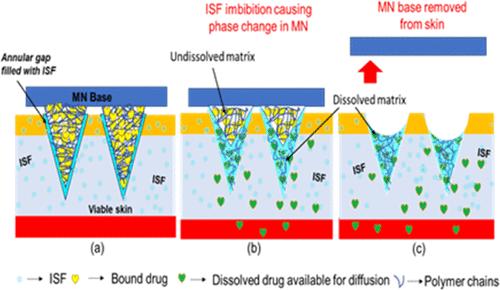Modeling of Dissolving Microneedle-Based Transdermal Drug Delivery: Effects of Dynamics of Polymers in Solution
IF 4.5
2区 医学
Q2 MEDICINE, RESEARCH & EXPERIMENTAL
引用次数: 0
Abstract
Dissolving microneedle (DMN)-assisted transdermal drug delivery (TDD) has received attention from the scientific community in recent years due to its ability to control the rate of drug delivery through its design, the choice of polymers, and its composition. The dissolution of the polymer depends strongly on the polymer–solvent interaction and polymer physics. Here, we developed a mathematical model based on the physicochemical parameters of DMNs and polymer physics to determine the drug release profiles. An annular gap width is defined when the MN is inserted in the skin, accumulating interstitial fluid (ISF) from the surrounding skin and acting as a boundary layer between the skin and the MN. Poly(vinylpyrrolidone) (PVP) is used as a model dissolving polymer, and ceftriaxone is used as a representative drug. The model agrees well with the literature data for ex vivo permeation studies, along with the percent height reduction of the MN. Based on the suggested mathematical model, when loading 0.39 mg of ceftriaxone, the prediction indicates that approximately 93% of the drug will be cleared from the bloodstream within 24 h. The proposed modeling strategy can be utilized to optimize drug transport behavior using DMNs.

基于溶解微针的透皮给药模型:溶液中聚合物动力学的影响
溶解微针(DMN)辅助透皮给药(TDD)近年来受到科学界的关注,因为它能够通过设计、聚合物的选择及其成分来控制给药速度。聚合物的溶解在很大程度上取决于聚合物与溶剂的相互作用以及聚合物的物理特性。在此,我们根据 DMN 的物理化学参数和聚合物物理特性建立了一个数学模型,以确定药物释放曲线。当 MN 插入皮肤时,会产生环形间隙宽度,积聚来自周围皮肤的间隙液(ISF),作为皮肤和 MN 之间的边界层。聚乙烯吡咯烷酮(PVP)被用作模型溶解聚合物,头孢曲松被用作代表药物。该模型与体内外渗透研究的文献数据以及 MN 的高度降低百分比十分吻合。根据所建议的数学模型,当负载 0.39 毫克头孢曲松时,预测结果表明约 93% 的药物将在 24 小时内从血液中清除。
本文章由计算机程序翻译,如有差异,请以英文原文为准。
求助全文
约1分钟内获得全文
求助全文
来源期刊

Molecular Pharmaceutics
医学-药学
CiteScore
8.00
自引率
6.10%
发文量
391
审稿时长
2 months
期刊介绍:
Molecular Pharmaceutics publishes the results of original research that contributes significantly to the molecular mechanistic understanding of drug delivery and drug delivery systems. The journal encourages contributions describing research at the interface of drug discovery and drug development.
Scientific areas within the scope of the journal include physical and pharmaceutical chemistry, biochemistry and biophysics, molecular and cellular biology, and polymer and materials science as they relate to drug and drug delivery system efficacy. Mechanistic Drug Delivery and Drug Targeting research on modulating activity and efficacy of a drug or drug product is within the scope of Molecular Pharmaceutics. Theoretical and experimental peer-reviewed research articles, communications, reviews, and perspectives are welcomed.
 求助内容:
求助内容: 应助结果提醒方式:
应助结果提醒方式:


